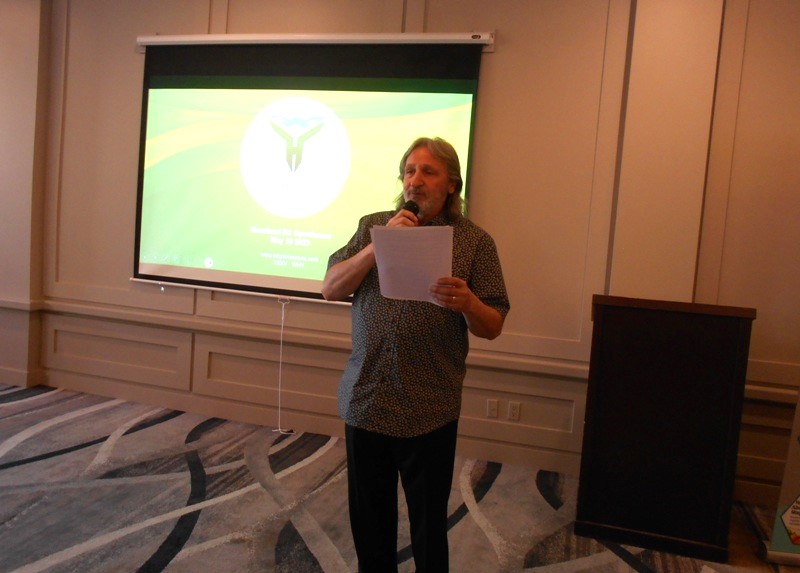Editorial: WHY and Record Ridge – time to comment
Most Rosslanders have heard of the proposal by West High Yield Resources (“WHY”) to develop a set of mineral claims on Record Ridge into an open-pit mine to extract magnesium ore and ship it to some destination in the United States for processing.
WHY has now published, on its website and in local Black Press news outlets, a “Notice of Application” for the Magnesium mine proposal. That signals the beginning of a 30-day comment period, if I understand the process correctly.
Comments should be civil, and should address how the proposed mine will affect us personally, or as a community; the details of concerns about employment, health, and safety, or the effects on local businesses or housing, are possible examples.
Comments should go to:
By mail: Regional Director, Ministry of Energy and Mines and Low Carbon Innovation, 202-100 Cranbrook Street North, Cranbrook, B.C. V1C 3P9
Or via email to: mmd-cranbrook@gov.bc.ca
There have been many articles published about the proposed project. One, in “Equity” magazine, states, “The mine, planned as an open-pit operation, is expected to have a lifespan of 20 years.” This is probably based on the amount of ore thought to be available: “The measured and indicated resources of this deposit have been estimated to be 43 million tonnes with a magnesium grade of 24.61%, containing approximately 10.6 million tonnes of magnesium.”
Extracting all that would result in a very large hole, among other things.
And yet, WHY is asking for a permit for an operation to last only two years, and to extract – depending on what information we are looking at – only 200,000 tonnes of ore per year; but wait, wasn’t the original proposal for 249,000 tonnes, to avoid the 250,000-tonne cut-off for an Environmental Assessment?
And then, when the Ministry indicated that an environmental Assessment would be done anyway because the projected haul was within 15% of the cut-off amount, WHY abruptly announced that it really only wanted to extract 200,000 tonnes per year. That’s the amount now declared in WHY’s Notice of Application.
Aside from the disconnect between the intentions declared in the Notice of Application and the hype put out in various investment and mining publications, local people have expressed concerns, summed up by City staff on the City’s website: “From the onset of learning about the RRIMM Project, local concerns raised by the City have included general provisions related to environmental / ecosystem damage, wildlife protection, recreational sites impact, project accessibility, traffic pattern volume changes, and potential onsite/offsite contamination. Similar concerns from the community have also been advanced to the City from residents and local groups.”
West High Yield has been working on the claims in question since approximately 2007, according to a 2009 article in this publication, with an interview with Frank Marasco, the CEO of WHY.
Yesterday, I spent time looking through the long list of studies WHY has had done in support of its application, but was unable to locate them again today for further review.
There was a Road Assessment Report. A portion of that report stated,
“The road, as described in the field assessment, is characterized by blind corners, sustained grades, narrow road widths, a gravel road surface and limited visibility. These road characteristics cannot all be eliminated consistently and cost-effectively.”
The report recommended that:
“Additional discussions with MoTI should be held to determine if the existing radio call signage should be removed. Typically, public highways are not radio assisted as it results in drivers with radios overdriving the road. Overdriving the road with a radio poses a significant risk to passenger vehicles who don’t have, and are not expected to have, the benefit of a radio.”
And,
“Work with the Ministry of Transportation and Infrastructure to complete the following upgrades to the Old Rossland Cascade Highway:
o Replace or install missing advisory signage on Old Rossland Cascade Highway related to new hauling to be consistent and improve visibility as needed.
o Review the existing “radio assisted” condition and install new “shared road
signage”. Radio frequencies shown on signage for mine traffic communication
only.
o Additional brushing at corners to improve sightlines.
o Upgrade and maintain existing pullouts where required to accommodate mine
truck traffic.
o Review additional recommendations outlined in the field assessment and jointly assess the feasibility of further long-term improvements.”
Having driven the Old Cascade Highway several times, I have great difficulty imagining how large ore trucks can safely pass each other on that road, or how residents of Big Sheep Creek or recreationists can be safe with ore truck traffic sharing that narrow, winding road.
There was also a plan for reducing dust, which has been a concern for residents, especially those who live along the Old Cascade Highway. One recommendation from that plan was to ” Install spray bar sprinklers to ensure continued wetting of area for blasting, drilling, and crushing activities.”
My questions are – how much water would that require every day? And, where would all that water come from? How often will it have to be hauled, and how far?
Another recommendation was to “Shield the crusher and other heavy equipment (such as generators, compressor, pumps, motors) or locate within an enclosure.”
That raises another question: will the crusher be enclosed? Who will enforce that recommendation, or will it be ignored because of expense?
I don’t recall whether there were recommendations for reducing dust along the Old Cascade Highway.
The comment period has begun, citizens. We all have an opportunity to be heard.


























